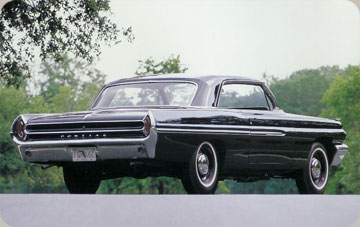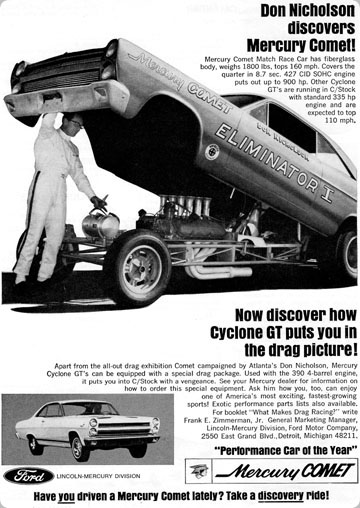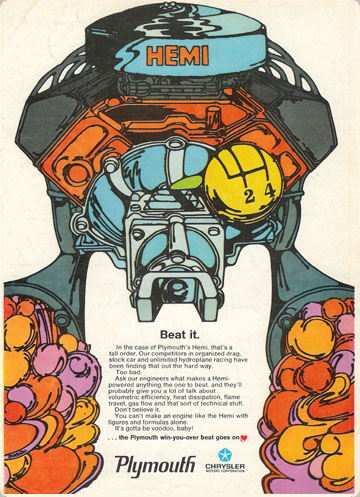|
What is a musclecar? Where did they come from? Although they were hard and fast, their definition is not. They weren't even known by that moniker until years later, and were often referred to as "super cars" by the enthusiast press of the day. Simply put, they are American-manufactured performance cars, or factory hot rods, and so the term could apply to almost any decade. More strictly, though, the term refers to Detroit's intermediate 2-door models that were equipped with performance packages, and the golden age of these cars was from 1964 to 1972.
Intake
Prior to 1964, there were most certainly cars that were performance-oriented. In the pre-WWII era, power and luxury usually went hand-in-hand, with the notable exception of the Ford flathead V8's. Between 1946 and 1964, we saw performance-oriented cars beginning to trickle down to the masses, cars such as the Olds 88, Hudson Hornet and the early Chrysler Hemi's. There were even "sports" cars like the Corvette and Thunderbird. But with the exception of the last two, high-performance was not marketed as part of an overall performance image. Except for a discreet badge or two, there were no exterior styling cues to distinguish models with high-performance engines from pedestrian models, and improved handling and braking received virtually no attention.
Compression
With the rise of NASCAR and NHRA in the late 1950's and early 1960's, racing success began to have its influence on the Big Three (General Motor, Ford, Chrysler), and the factories began turning out high-performance parts to support hard-core stock and drag racers. To qualify in certain racing categories, Detroit even had to produce a minimum number of whole cars equipped with the racing pieces. These cars are seen as the immediate predecessors of the musclecar, and can legitimately be included under the larger umbrella definition: 406ci Galaxies, 409ci Biscaynes, 413 and 426ci Max Wedge Dodges and Plymouths, 421ci Catalinas. What sets them apart from their progeny is that they were generally based on full-size platforms, and targeted largely at racers who would then proceed to modify them to go forth and do battle on the nation's racetracks. This is evidenced by the fact that they had no special model name, and were usually sold with no other options than the heavy-duty drivetrain, as stripped-down models were lighter; some didn't even have radios or heaters.

The 1962 Pontiac Catalina.
Ignition
In 1964, General Motors introduced its new intermediate models (Skylarks, Cutlasses, Chevelles, Tempests), which rode on a new full-frame platform of 115" for their 2-doors. By policy, none could have an engine larger than 330 cubic inches as standard equipment. Over at Pontiac, it was a small group of innovators who saw a way to keep Pontiac's performance image (put on hold by a 1963 GM ban on racing support) out in front of the public by taking the 389 engine used in their full-size cars and offering it as an option in the new Tempest/LeMans body. This became the first GTO, the car most often credited as the first musclecar. Besides the larger engine, it had a beefier suspension, distinctive trim and emblems, simulated hood scoops, and used a Hurst shifter for 4-speed models, the first use of a recognized, aftermarket racing part as standard equipment.

After GM banned racing sponsorship, drag racer "Dyno" Don Nicholson joined the Mercury team. He is shown in this advertisement with the well-known 1966 Comet-based flip-top funny car.
Pontiac's sister divisions soon followed suit when they saw the sales success of that first GTO: Oldsmobile with the 442, Buick with their Gran Sport, and Chevy with the Chevelle SS396. Ford and Mercury joined the party with their Fairlane GT390 and Comet Cyclone; and Dodge and Plymouth with their Coronet R/T and GTX. The rise of the ponycars (Mustang, Cougar, Camaro, Firebird, Barracuda, Challenger, AMX and Javelin) further swelled the ranks of the musclecars when equipped with performance packages.
1970 is often seen as the year that the musclecar reached its peak. GM lifted its 400ci limit on intermediate engine size, making way for Chevy's 454, and Buick's, Olds' and Pontiac's 455, to be offered. Chrysler dropped their almighty 426 Hemi into the new Cuda and Challenger R/T, and offered its wildest paint colors, stripes and decals. Ford offered Boss 302's and Boss 429's, 428 and 429 Cobra Jets in a variety of models. Even American Motors finally built an intermediate musclecar, the Rebel Machine.

This stylish advertisement from Plymouth appealed to young buyers.
Exhaust
But insurance rates had already started to rise for these cars, and Federally-mandated emission standards were becoming tougher to meet. GM was the first to raise the white flag by reducing compression ratios in 1971 to allow the use of unleaded gasoline. Chrysler and Ford followed in 1972, and we saw the demise of the Hemi, the 440-6bbl, and the 429 CJ's. 5-mph bumper requirements in 1973, and catalytic convertors in 1975, really spelled the end. Some musclecar nameplates soldiered on, but increasingly became not much more than trim and handling packages. Bragging about horsepower and torque became taboo, with "fuel efficiency" the new watchword.
As time permits, I will flesh out this story in future installments....
©2004 musclecar mentor
All Rights Reserved.
|


